Are you experiencing hair loss and looking for a natural solution? Incorporating specific workouts into your daily routine can be a game-changer. Research suggests that certain exercises can help reduce hair fall by improving blood circulation and reducing stress.
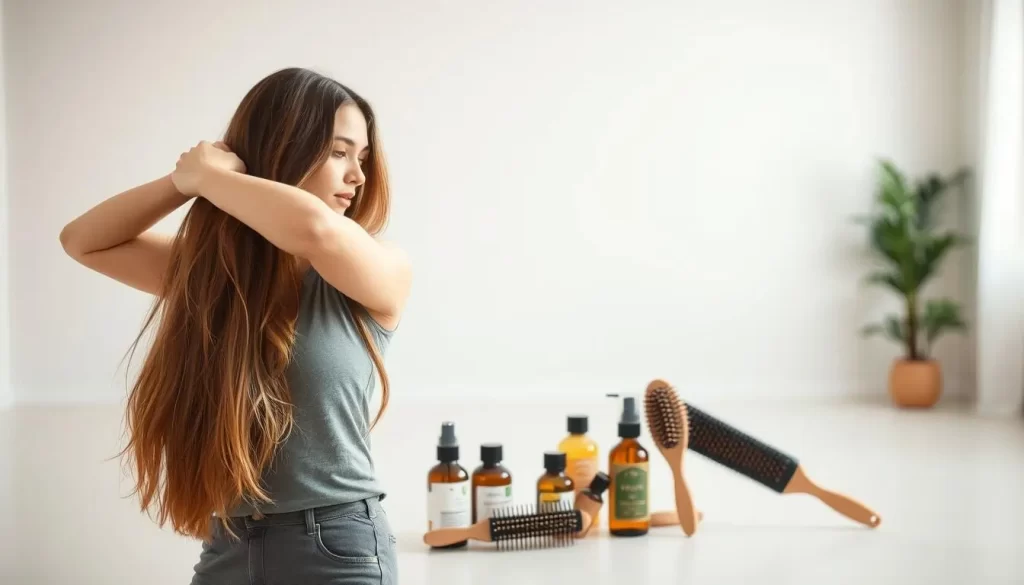
hairfall exercise
By engaging in simple hairfall exercise routines, you can promote healthy hair growth and strengthen your hair follicles. This approach not only tackles hair loss but also enhances overall well-being.
Key Takeaways
- Regular workouts can help reduce hair fall.
- Improved blood circulation promotes healthy hair growth.
- Exercise routines can be simple and easy to incorporate.
- Reducing stress through exercise can minimize hair loss.
- A healthy lifestyle can lead to stronger hair follicles.
Understanding Hair Loss: Causes and Contributing Factors
Hair loss is a widespread concern affecting millions worldwide, and understanding its causes is crucial for finding effective solutions. Hair loss, or alopecia, can manifest in various forms and can be triggered by a multitude of factors.
Common Causes of Hair Loss
Hair loss can be attributed to a combination of genetic, hormonal, and environmental factors. Genetics play a significant role, with conditions like androgenetic alopecia being hereditary. Hormonal changes, particularly those involving dihydrotestosterone (DHT), can also lead to hair loss. Other factors include stress, nutritional deficiencies, and certain medical conditions.
- Genetic predisposition
- Hormonal imbalances
- Nutritional deficiencies
- Stress and anxiety
- Medical conditions like alopecia areata
How Physical Activity Affects Hair Health
Physical activity has a positive impact on hair health by improving circulation, reducing stress, and balancing hormones. Regular exercise can enhance blood flow to the scalp, promoting healthy hair growth. Exercise also helps in managing stress levels, which is crucial since high stress is linked to hair loss.
The Science Behind Exercise and Hair Growth
Exercise influences hair growth through several mechanisms. It improves blood circulation, ensuring that hair follicles receive adequate nutrients and oxygen. Additionally, physical activity helps regulate hormones and reduce stress, both of which are beneficial for preventing hair loss. By incorporating hair loss workout routines into your lifestyle, you can potentially prevent hair loss with exercise and promote overall hair health.
The Connection Between Stress and Hair Loss
Understanding the link between stress and hair shedding is crucial for developing effective hair loss prevention strategies. Stress affects the body in multiple ways, and its impact on hair health is significant.
How Stress Triggers Hair Shedding
When the body experiences stress, it responds by releasing more cortisol, a hormone that can disrupt the normal hair growth cycle. High cortisol levels can cause hair follicles to enter the resting phase, leading to increased shedding. This condition, known as telogen effluvium, can be triggered by both physical and emotional stress.
Furthermore, stress can lead to inflammation and oxidative stress, which can damage hair follicles and contribute to hair loss. Reducing stress is, therefore, crucial for maintaining healthy hair.
Stress-Reduction Benefits of Regular Exercise
Regular exercise is a natural remedy for hair fall through its stress-reduction benefits. Physical activity helps lower cortisol levels and improve overall well-being. Exercises such as yoga, Pilates, and cardio workouts are particularly effective in reducing stress.
Engaging in best exercises to stop hair fall not only improves physical health but also enhances mental health by releasing endorphins, also known as “feel-good” hormones. This dual benefit makes regular exercise a valuable component of a hair loss prevention strategy.
Effective Hairfall Exercise Routines for Preventing Hair Loss
To combat hair fall, it’s essential to adopt a comprehensive exercise regimen that targets the scalp, improves circulation, and reduces stress. Hair loss is a multifaceted issue that can be addressed through a variety of exercises that not only promote hair growth but also enhance overall well-being.
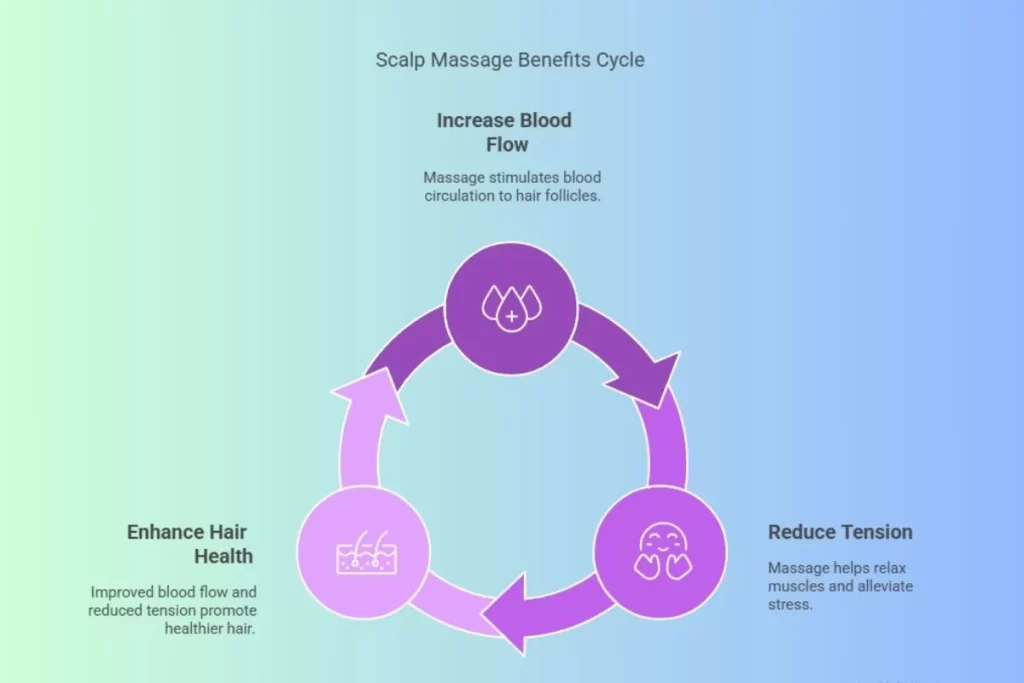
Scalp Massage Techniques
Scalp massage is a simple yet effective technique for stimulating hair growth. By massaging your scalp, you increase blood flow to the hair follicles, which can help to strengthen them and promote growth.
Fingertip Massage Method
The fingertip massage method involves using your fingertips to massage your scalp in circular motions. This technique helps to loosen tension in the scalp and improve blood circulation.
Tools for Enhanced Scalp Stimulation
In addition to manual massage, there are various tools available that can enhance scalp stimulation, such as scalp massagers and rollers. These tools can help to further increase blood flow and reduce tension.
Yoga Poses for Hair Growth
Yoga is another effective way to promote hair growth by reducing stress and improving circulation. Certain yoga poses can help to stimulate hair growth by increasing blood flow to the scalp.
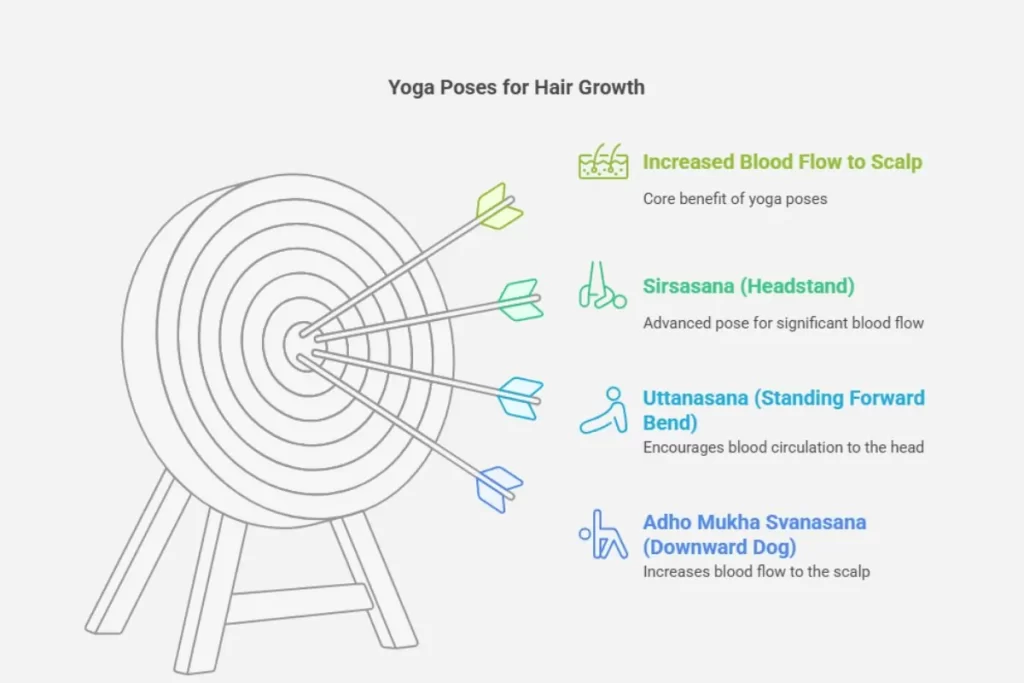
Inverted Poses to Increase Blood Flow
Inverted yoga poses, such as the downward-facing dog and headstand, can help to increase blood flow to the scalp, promoting hair growth. These poses also help to reduce stress, a common contributor to hair loss.
Breathing Exercises for Stress Reduction
Yoga also involves various breathing exercises that can help to reduce stress, a key factor in hair loss. By minimizing stress through yoga and breathing exercises, you can create a more conducive environment for hair growth.
Cardiovascular Exercises for Improved Circulation
Cardiovascular exercises are essential for improving circulation, which is critical for promoting hair growth. Regular cardio workouts can help to strengthen the heart and increase blood flow to the scalp.
Optimal Duration and Intensity
For optimal results, it’s recommended to engage in at least 30 minutes of moderate-intensity cardio exercise per session, several times a week. This can include activities such as jogging, cycling, or swimming.
Best Cardio Workouts for Hair Health
Some of the best cardio workouts for hair health include brisk walking, jogging, cycling, and swimming. These exercises not only improve circulation but also help to reduce stress and promote overall health.
Neck and Shoulder Exercises for Better Blood Flow
Neck and shoulder exercises can also play a crucial role in promoting hair growth by improving blood flow to the scalp. Simple exercises such as neck stretches and shoulder rolls can help to reduce tension and improve circulation.
Creating a Weekly Hair-Healthy Exercise Schedule
To combat hair loss effectively, incorporating a balanced exercise regimen into your weekly routine is essential. A well-rounded workout schedule not only promotes overall health but also stimulates hair growth by improving circulation and reducing stress.
Balancing Different Types of Exercise
A balanced exercise routine should include a mix of cardiovascular activities, strength training, and flexibility exercises. Cardiovascular exercises, such as jogging or cycling, improve heart health and increase blood flow to the scalp. Strength training helps build muscle and can enhance overall physical condition. Flexibility exercises, like yoga, can reduce stress and improve circulation.
Sample 7-Day Routine for Beginners
For those new to regular exercise, starting with a manageable routine is crucial. Here’s a sample 7-day schedule:
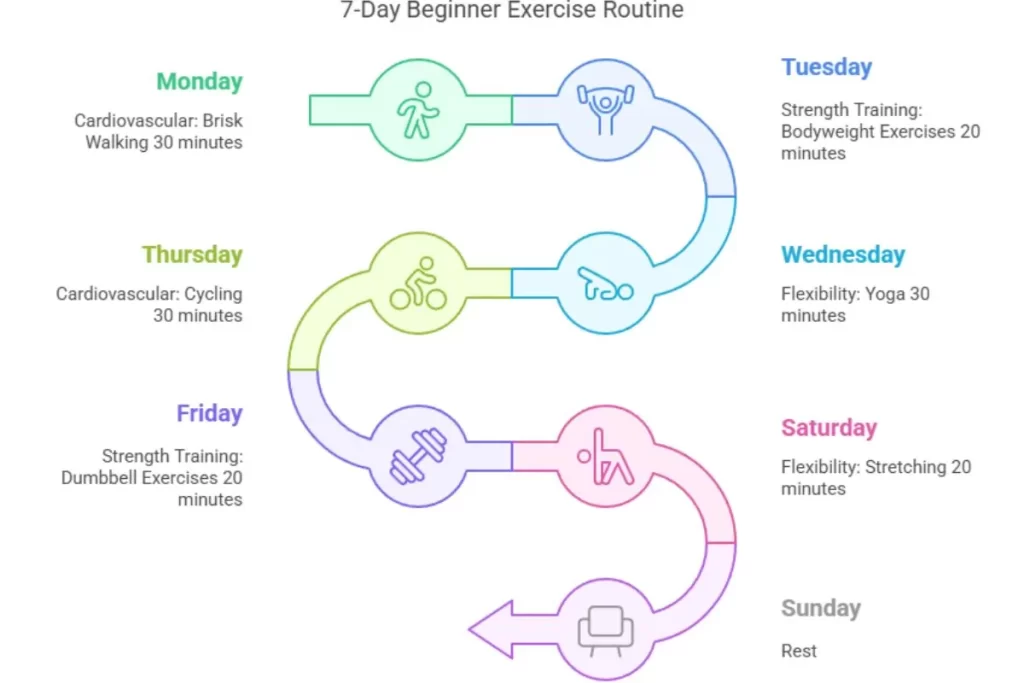
Progressing Your Hairfall Exercise Program
As you become more comfortable with your routine, it’s essential to challenge yourself to continue making progress. This can be achieved by increasing the intensity of your workouts, adding more days to your exercise schedule, or trying new activities.
Proper Hair Care During and After Workouts
Maintaining healthy hair while working out requires a thoughtful approach to hair care before, during, and after exercise. When you exercise regularly, you’re not only improving your overall health but also potentially boosting your hair’s health through increased blood flow and reduced stress. However, exercise can also expose your hair to sweat, friction, and potential damage.
Pre-Exercise Hair Protection Tips
Before you start your workout, taking a few simple steps can help protect your hair. Tying your hair back can reduce friction and prevent it from getting in the way. Using a hair tie or bandana made from a gentle material can help minimize hair breakage. Additionally, applying a pre-workout hair serum can help shield your hair from damage caused by sweat and friction.
Post-Workout Hair Care Routine
After your workout, it’s essential to care for your hair to remove sweat and prevent buildup. Gently washing your hair with a mild shampoo can help cleanse it without stripping it of its natural oils. Using a microfiber towel or an old t-shirt to dry your hair can reduce friction and prevent breakage. For those with longer hair, using a wide-tooth comb can help detangle hair gently.
Best Hair Products for Active Individuals
For individuals with active lifestyles, choosing the right hair products is crucial. Sulfate-free shampoos and moisturizing conditioners can help maintain hair health. Additionally, using a leave-in conditioner or hair mask once or twice a week can provide extra nourishment. For styling, opting for lightweight, non-greasy products can help keep your hair looking healthy and vibrant.
| Hair Care Product | Benefits for Active Individuals |
| Sulfate-free shampoo | Gently cleanses hair without stripping natural oils |
| Moisturizing conditioner | Hydrates and nourishes hair |
| Leave-in conditioner or hair mask | Provides extra nourishment and hydration |
| Lightweight styling products | Keeps hair styled without weighing it down |
Nutrition and Hydration to Support Exercise Benefits
To maximize the hair growth benefits of your exercise routine, it’s essential to fuel your body with the right nutrients. A well-balanced diet complements your exercise regimen, supporting overall hair health and enhancing the effectiveness of your workouts in preventing hair loss.

Essential Nutrients for Hair Growth
A diet rich in vitamins and minerals is crucial for hair health. Protein is particularly important as hair is made of protein. Include protein-rich foods like lean meats, fish, eggs, and legumes in your diet. Iron and zinc are also vital; they help carry oxygen to your hair follicles and support hair growth. Foods rich in these minerals include red meat, spinach, and oysters.
Additionally, vitamins like biotin, vitamin C, and vitamin E play significant roles in hair health. Biotin helps strengthen hair follicles, while vitamin C enhances iron absorption. Nuts, seeds, and leafy greens are excellent sources of these vitamins.
Hydration Guidelines During Exercise
Staying hydrated is crucial during exercise to maintain hair health. Water helps keep your scalp healthy and supports the hair growth cycle. Aim to drink at least eight glasses of water a day, and increase your intake during intense or prolonged workouts.
Electrolytes, such as sodium and potassium, are also important for maintaining hydration balance. Consider including electrolyte-rich beverages or foods during or after your workouts, especially if you’re engaging in high-intensity exercises.
Pre and Post-Workout Nutrition for Hair Health
What you eat before and after your workouts can impact your hair health. For pre-workout nutrition, focus on complex carbohydrates and lean proteins to provide sustained energy. Whole grain toast with avocado or a banana with almond butter are good options.
Post-workout, consume a mix of protein and carbohydrates within 30-60 minutes after your exercise. This helps in recovery and supports hair growth. A smoothie with protein powder, berries, and spinach is an excellent post-workout snack.
By combining a balanced diet with regular exercise, you can effectively support hair health and work towards preventing hair loss. Remember, consistency is key, and making these practices a part of your daily routine will yield the best results.
Lifestyle Modifications to Enhance Exercise Results
To maximize the benefits of hairfall exercises, it’s essential to consider other aspects of your lifestyle that can contribute to healthier hair and mitigate hair loss. While regular exercise is a crucial component of hair health, other lifestyle factors play a significant role in enhancing its effectiveness.
Sleep Quality and Hair Regeneration
Quality sleep is vital for overall health, including hair regeneration. During sleep, the body repairs and regenerates tissues, including hair follicles. Ensuring 7-8 hours of sleep per night can significantly support hair health. Poor sleep quality can lead to increased stress levels, which may exacerbate hair loss.
Reducing Environmental Damage
Environmental factors such as pollution, UV radiation, and harsh weather conditions can damage hair and scalp, potentially leading to hair loss. Using protective measures like hats or hair serums with SPF can help shield your hair from environmental stressors. Additionally, maintaining a clean scalp by regularly washing your hair with a gentle shampoo can reduce the risk of scalp irritation.
Combining Exercise with Other Hair Loss Treatments
For individuals experiencing significant hair loss, combining hairfall exercise with other treatments may yield better results. This can include medical treatments like minoxidil, low-level laser therapy (LLLT), or platelet-rich plasma (PRP) therapy. Consulting with a healthcare professional to determine the best combination of treatments tailored to your specific needs is advisable.
Tracking Progress: What to Expect from Your Hairfall Exercise Routine
As you embark on your hairfall exercise routine, it’s essential to understand what to expect and how to track your progress. Consistency is key when it comes to exercises for reducing hair fall, and being aware of the timeline for results will help you stay motivated.
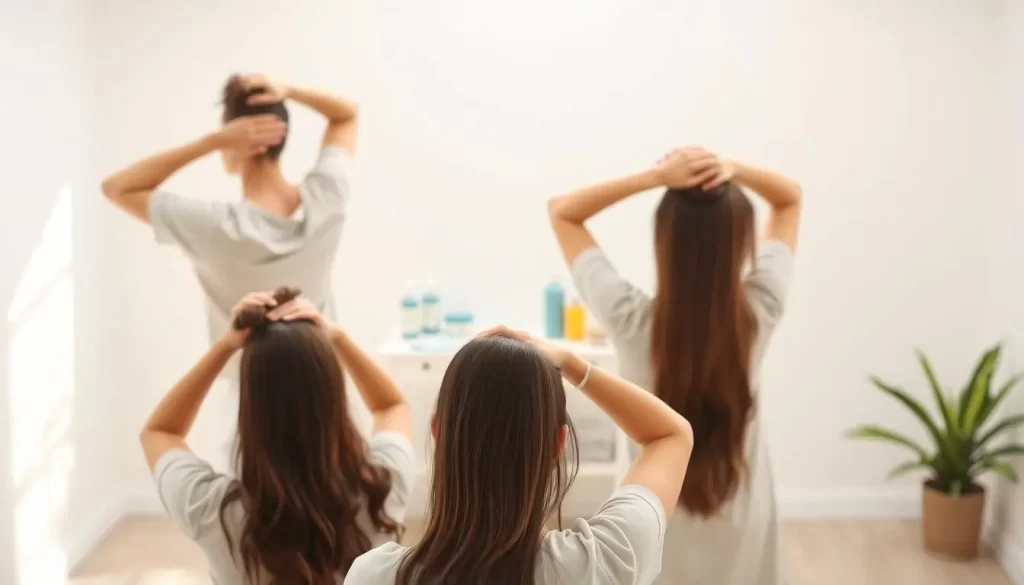
Realistic Timelines for Visible Results
Visible results from a hairfall exercise routine can vary from person to person. Generally, it may take a few months to start noticing improvements in hair health. It’s crucial to be patient and persistent with your workout tips to prevent hair fall.
Most people can expect to see initial results within 3-4 months, with more significant improvements after 6 months. Regular exercise, combined with a balanced diet and proper hair care, will contribute to healthier hair.
Methods to Document Hair Growth Improvements
Documenting your progress is vital to understanding the effectiveness of your hairfall exercise routine. There are several methods to track hair growth improvements:
- Photographic records: Take regular photos of your hair to track visual changes.
- Hair journal: Keep a journal to record your hair care routine, exercise schedule, and any changes you notice.
- Measurement: Measure your hair length and thickness regularly to quantify growth.
By combining these methods, you can get a comprehensive view of your progress and make adjustments to your routine as needed.
Potential Pitfalls: When Exercise Might Worsen Hair Loss
Incorporating the right exercises into your routine can help mitigate hair loss, but it’s equally important to be aware of the potential pitfalls. While regular physical activity is known to promote overall health and well-being, certain aspects of an exercise regimen might inadvertently contribute to hair loss if not managed properly.
Signs of Excessive Physical Stress
Excessive physical stress from intense workout routines can lead to hair loss. Signs that your exercise regimen might be too strenuous include persistent fatigue, increased hair shedding, and changes in menstrual cycle for women. It’s crucial to listen to your body and recognize these signs early to prevent long-term damage.
Adjusting Your Routine for Optimal Results
To avoid exacerbating hair loss, it’s essential to strike a balance in your exercise routine. This can be achieved by mixing low-intensity activities like yoga or brisk walking with more strenuous workouts. Additionally, ensuring proper nutrition and hydration before, during, and after exercise can help mitigate potential negative effects on hair health.
| Exercise Type | Intensity Level | Impact on Hair Health |
| Yoga | Low | Promotes blood flow, potentially beneficial |
| Cardio (e.g., Running, Cycling) | High | Can be stressful if overdone, potentially negative |
| Weightlifting | Variable | Can improve overall health, but excessive strain may be harmful |
Conclusion: Maintaining Consistency for Long-Term Hair Health
Maintaining a consistent hairfall exercise routine is crucial for achieving long-term hair health. By incorporating exercises that promote healthy hair growth, such as scalp massages, yoga, and cardiovascular activities, individuals can reduce hair loss and improve overall hair well-being.
Consistency is key to seeing lasting results from exercise for healthy hair growth. Sticking to a well-rounded routine that includes a mix of physical activity, proper nutrition, and good hair care practices will help individuals achieve their hair health goals.
By combining regular hairfall exercise with a balanced lifestyle, individuals can enjoy healthier, more resilient hair. Stay committed to your exercise plan and experience the benefits of a comprehensive approach to hair care.
FAQ about Exercise for hair growth
What are the best exercises to stop hair fall?
Exercises like scalp massage, yoga, cardiovascular exercises, and neck and shoulder exercises can help prevent hair loss. These exercises promote blood flow to the scalp, reduce stress, and improve overall circulation.
How does stress contribute to hair loss, and how can exercise help?
Stress can trigger hair shedding by disrupting the normal hair growth cycle. Regular exercise helps reduce stress levels, promoting a healthy environment for hair growth.
Can exercise alone prevent hair loss, or are there other factors to consider?
While exercise is beneficial, it’s also important to maintain a balanced diet, stay hydrated, and practice good hair care. Combining these habits with regular exercise can enhance its benefits for hair health.
How often should I exercise to see improvements in hair health?
Consistency is key. Aim for a balanced routine that includes a mix of cardiovascular exercises, yoga, and scalp massage, ideally 3-4 times a week, to start seeing improvements in hair health.
Are there any specific nutrients that support hair growth during exercise?
Essential nutrients like protein, vitamins (especially Biotin and Vitamin D), and minerals (such as Iron and Zinc) play a crucial role in supporting hair growth. Ensuring adequate intake of these nutrients is vital for maximizing the benefits of exercise on hair health.
How can I track the progress of my hairfall exercise routine?
Tracking progress can be done by monitoring hair growth through photographs, measuring hair length, or using a hair growth tracking app. Be patient, as visible results may take time.
Can excessive exercise worsen hair loss?
Yes, excessive physical stress from over-exercising can potentially worsen hair loss. It’s essential to find a balance and listen to your body’s needs to avoid overdoing it.
What are some lifestyle modifications that can enhance the results of exercise on hair health?
Improving sleep quality, reducing exposure to environmental damage, and combining exercise with other hair loss treatments can enhance the benefits of exercise for hair health.
How long does it take to see results from a hairfall exercise routine?
Results can vary, but with consistent effort, you may start to see improvements within a few months. Being consistent and patient is crucial.



Pingback: Experiencing Hair Loss After Laser Hair Removal? Get the Facts